Oscar-winning Director Sharmeen Obaid-Chinoy on Her New Documentary, ‘Diane von Furstenberg: Woman in Charge’
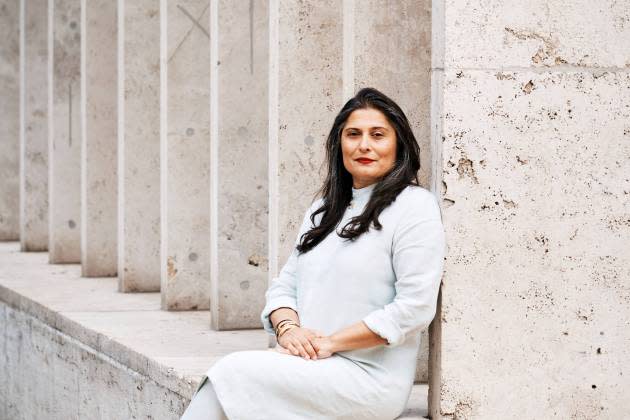
It’s a Thursday morning in May, and Sharmeen Obaid-Chinoy, the Oscar-winning director, is visiting New York from her home in Pakistan to talk about her new documentary, “Diane von Furstenberg: Woman in Charge.” Sitting down at The Smith on the Upper West Side, Obaid-Chinoy says she sees a lot of parallels between herself and von Furstenberg, both working women juggling families and careers and trying to make the world a better place for women.
“The reason that I wanted to do this film is because this is a film about a woman who charts her own life, who lived life by her own terms. When she fell down, she would pick herself up and she would reinvent herself constantly,” says Obaid-Chinoy.
More from WWD
The documentary’s codirector and producer says so many women today don’t chart their own journey because either they’re afraid to take the chance, or because they listen to the voices in their head.
Obaid-Chinoy says that’s the story that she wanted to tell. “I wanted to create an anthem for women so that when they watch the film, there would be something in that film that will resonate with them. You lose a loved one, you have a traumatic experience in your life. You’re a working mother and juggling your children. Your business falls apart.
“She [Diane] picks herself up, but you wouldn’t even know that she just lost all her money,” says Obaid-Chinoy.
The Filming Process
For two years, Obaid-Chinoy and codirector and producer Trish Dalton followed von Furstenberg around, traveling to Paris, Brussels, Venice, even Bali, to show a complete story of her life. Obaid-Chinoy says she was lucky because von Furstenberg had documented her life from when she was a young woman in her early 20s. She wrote a diary and had thousands of photographs and videos. She saved all of her family albums, invitations and cards her children made. “One of the things that I realize is that her children traveled everywhere, and she took them everywhere,” says Obaid-Chinoy. Von Furstenberg gave the codirectors free rein to all her archives in Connecticut.
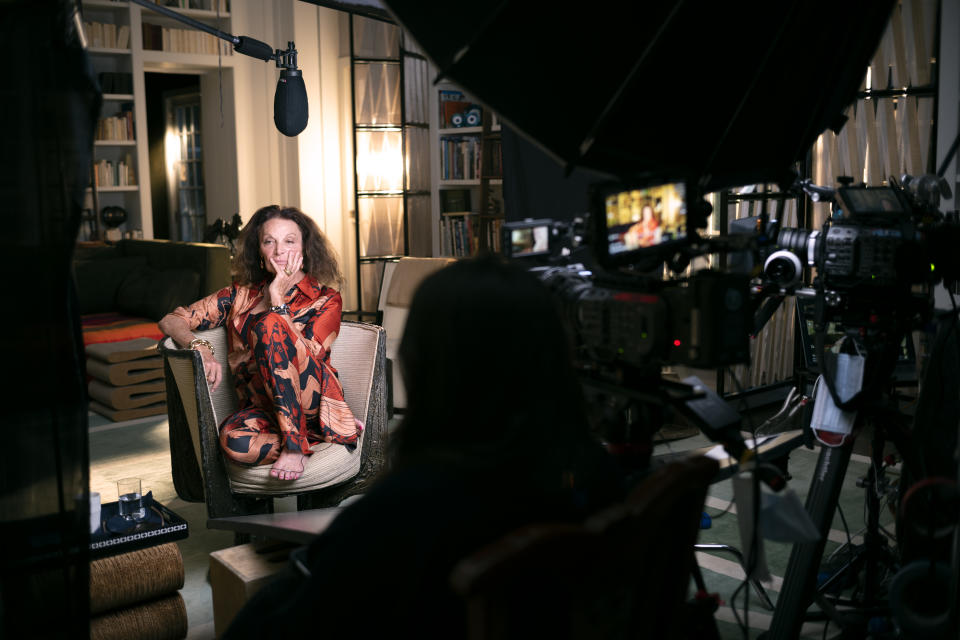
“We tried to match her energy and her world,” says Dalton, who was interviewed separately about the film. Dalton and Obaid-Chinoy previously codirected “Student Athlete,” about the NCAA and college sports in America. “She [Diane] has so much color, collages and photos in her life, she’s always taking photos. To me, it was important as a filmmaker to reflect her world and her energy. Not just in what was said but what we were watching,” says Dalton.
The filmmakers also spoke to many of von Furstenberg’s friends such as Fran Lebowitz, Gloria Steinem, Marc Jacobs, Bob Colacello, Karlie Kloss, Vanessa Friedman, Oprah Winfrey, Christian Louboutin, Edward Enninful and Hillary Rodham Clinton, who are all featured in the film.
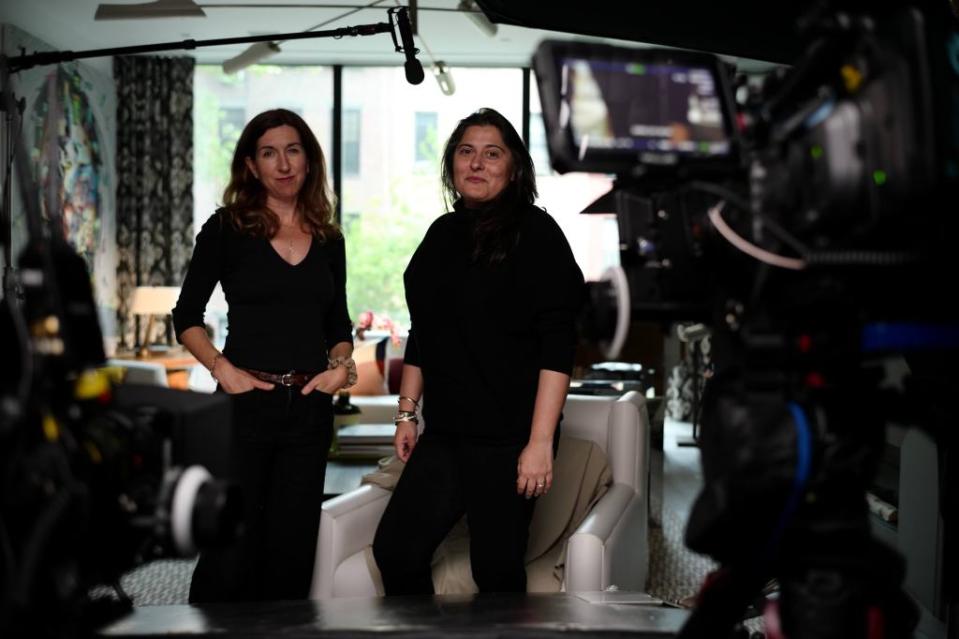
Obaid-Chinoy, who has won Oscars for two of her documentary shorts: “A Girl in the River: The Price of Forgiveness” and “Saving Face,” is most known for her work in films that highlight gender inequality against women. She is also the director of the upcoming film “Star Wars: The Next Jedi,” the first woman and first person of color to direct a “Star Wars” feature film. Obaid-Chinoy brought on Dalton to codirect the von Furstenberg film when she was working on the script for “Star Wars” to ensure she would be able to complete both films.
When asked why she chose von Furstenberg to feature in a celebrity documentary, she explains that the designer had reached out to her to make a film about the women she celebrates and gives awards to through Vital Voices and the DVF Awards. They spoke and had a few Zoom calls and talked about that idea. “And inevitably, I said, ‘Look, Diane, people will want to hear your story. And she said, ‘That’s not the story I want.'” And then the next year, Obaid-Chinoy got a call from Fabiola Beracasa Beckman, who became the film’s producer, who said, “‘Diane is ready to tell her story. But she’s saying that only if you direct it.'”
Obaid-Chinoy and von Furstenberg met in 2013 when Cindi Leive, former editor in chief of Glamour Magazine, gave Obaid-Chinoy a Woman of the Year award, and Leive got von Furstenberg to present it to her onstage. Obaid-Chinoy and von Furstenberg kept in touch over the years.
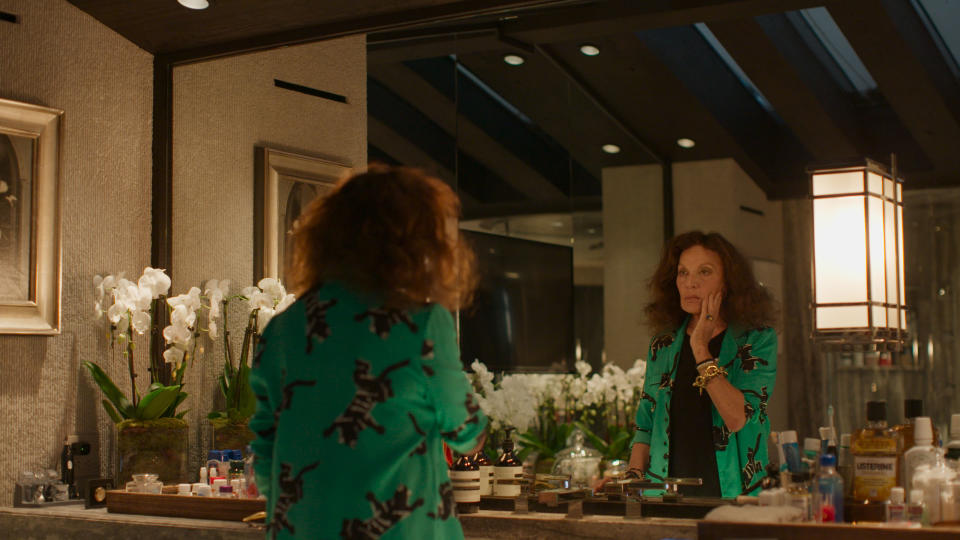
A Changing World
Obaid-Chinoy says the film is much more than a look at von Furstenberg’s life and career. “The film is also about the way the world changed, right? It’s about Europe in the ’50s and ’60s, and New York in the ’70s. And then it’s about Bali, and it’s about being back in Paris, and it’s about Venice. With each city that we go to we craft a narrative about that place, whether we use the music or we use the graphics.”
The result is a colorful, fast-paced film that shows a whirlwind tour of von Furstenberg’s life from her childhood as the daughter of a Holocaust survivor to her early marriage to a German prince, Egon von Furstenberg, and being part of a celebrity couple, to the rapid rise of her business and her early fame as the creator of the wrap dress, to wild nights at Studio 54, to her divorce, the business’ downfall, and ultimately the revival of her brand.
Obaid-Chinoy says von Furstenberg was completely honest all the time. “She revealed a lot of things. Her life is sort of an open book, right? And that’s what the film is. It’s an open book into her life. She is unapologetic about the men she was with, the business shortcomings, the personal heartache she had, finding love, finding a soulmate, raising kids. It’s the good, the bad, the ugly,” she says. Von Furstenberg even talks about her first love affair with a woman and how she eventually married her soulmate, Barry Diller, who is openly gay.
“I think women will come away with a nuanced understanding of who the woman is and what her battles have been,” says Obaid-Chinoy.
When asked how they navigated the sexuality part, Dalton says, “It’s her voice. She says it. She says she doesn’t have secrets, and she says, ‘Why would I hide?’ She says ‘own it,’ and ‘be in charge.’ Especially during these times, when women’s rights are being challenged and questioned. [She says] why can’t a woman do what men can do? The idea of a double standard is something she’s really against. She’s always been like that.”
In one scene in the film, von Furstenberg wins an award, and in that moment, she realizes that she is the child of a Holocaust survivor and it blows her mind. She had never thought of that before.
“Sometimes it takes a traumatic incident to make you realize who you are. I think that in her case, her mother had tried to shield her from the direct horrors because she had been so brave for so long, but when she broke down, that’s when Diane really saw what that was. But then she [her mother] recovered,” says Obaid-Chinoy.
Life Lessons
She says that von Furstenberg taught Obaid-Chinoy some valuable life lessons, especially about balancing a career and motherhood, and that you might miss events in your children’s lives while you’re on the road, but it doesn’t mean you love them any less. “You have one life to live and you have to follow your dreams and your heart. And if men can follow their dreams and follow their heart, why can’t women? And that’s such an important lesson. She reinforced that in me. In hearing Diane’s story, I learned so much about my own life and what I need to do,” says Obaid-Chinoy.
“You have one life to live and you have to follow your dreams and your heart. And if men can follow their dreams and follow their heart, why can’t women? And that’s such an important lesson. She reinforced that in me. In hearing Diane’s story,
I learned so much about my own life and what I need to do.”~ Sharmeen Obaid-Chinoy
Obaid-Chinoy says she and von Furstenberg speak every day and have a deep connection to each other. “She’s encouraged me to dream big. I’ve always dreamt big, but she said to me, ‘dream bigger.’ And she gives me advice all the time about what I should do. And we talk a lot. We talk about the impact of our families and the impact of politics and who we are and where we came from. I mean, she’s a child of a Holocaust survivor and I’m a Muslim woman, and I’m telling her story. We bond on that a lot. We talk about that all the time. About how similar we are and how similar our roots are.”
Throughout her life, von Furstenberg has always said, “Be a Woman” and don’t feel you need to dress like a man to be taken seriously. “That’s what she taught me by the way,” says Obaid-Chinoy.
Obaid-Shinoy recalls when she started out in film, she was filming in war zones and countries in turmoil. “In my early years, I would make films and you would see me wearing a red scarf on my head. I wanted people to know that I was a woman even though I had a very tough exterior. When I went into a war zone, people around me would say, ‘Temper down, don’t stand out, don’t wear anything that’s colorful and don’t draw attention to yourself as a woman,’ and I would say to them, ‘I am a woman. They need to see and recognize I’m a woman.’ And I didn’t know where that was coming from. And then when I heard Diane, [I thought] so maybe women think like that.”
Obaid-Shinoy says von Furstenberg had no say in the editing process and when she finally showed her the completed film, the director was nervous. She says von Furstenberg was moved. Diller watched it on a different occasion. “He loved it. He said ‘this is a very honest portrayal of Diane,'” recalls Obaid-Chinoy.
Diane von Furstenberg’s Opinion
Reached for comment, von Furstenberg says that when she was first shown the film she felt, “it was like being at the gynecologist’s office.”
“I laughed the entire time. Laughing for me is my defense mechanism, and then I got completely paranoid. Why am I doing this? It is a very unapologetic portrait, and if I can be inspiring, I support it completely,” says von Furstenberg.
“I love Sharmeen, and I’ve grown to love Sharmeen even more. I trust her,” she says, adding that the good thing about the movie is they shot it for two years, so she gets to keep everything they didn’t use in the film.
In making the film, Obaid-Chinoy says she spent so much time with Diller and von Furstenberg. “They have such a beautiful relationship. They have a deep friendship and respect. And the banter is constant. And then there’s long pauses of silence. They’re very comfortable around each other. They have a wonderful energy around each other. They have an excellent rapport. They spend time together in Connecticut, he was just there in Venice,” she says.
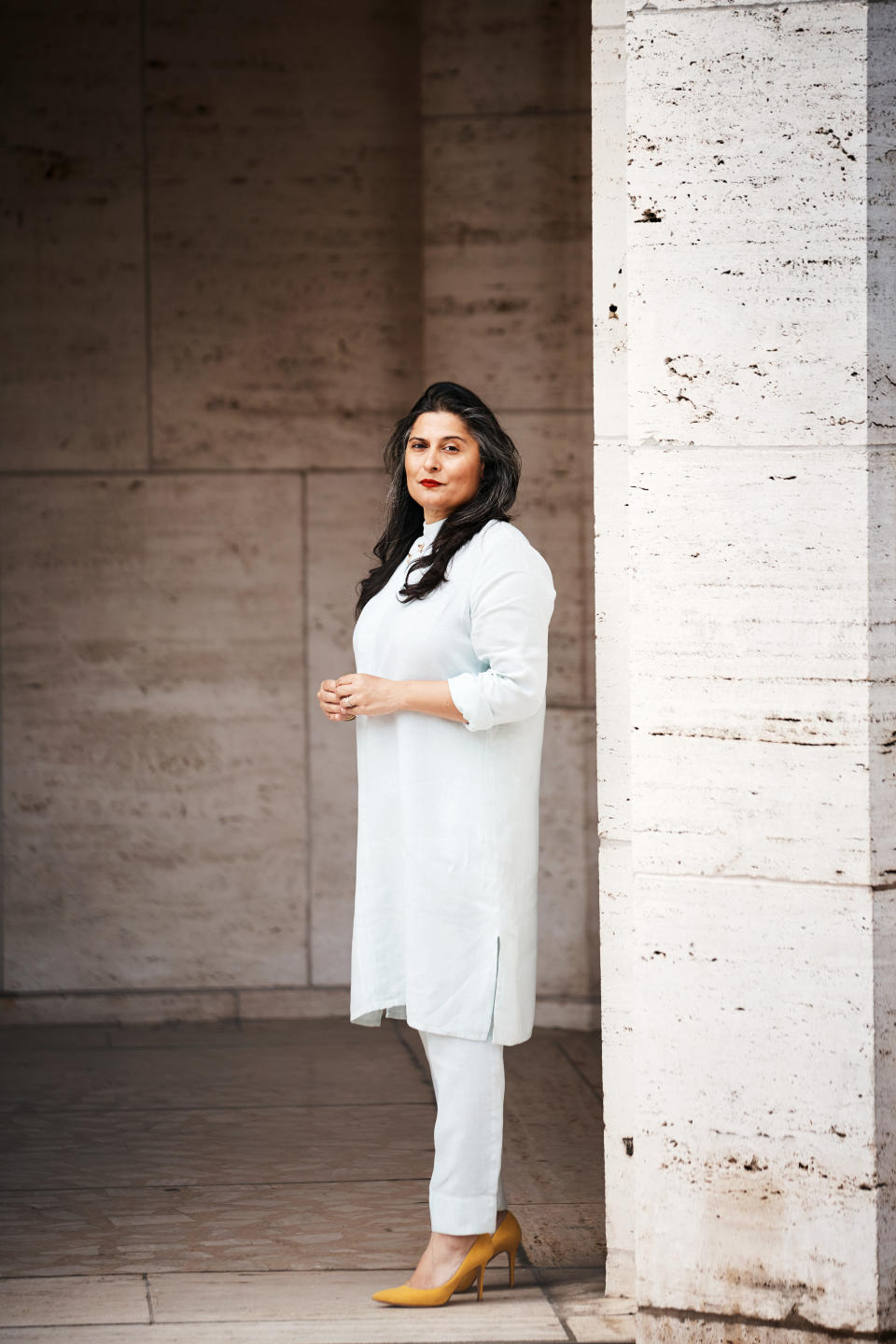
“They’re very much soulmates. I mean, definitely a definition of a soulmate is someone whom you have a deep connection with, right? They have known each other since they were in their early 30s. Her children are his children; her grandchildren are his grandchildren,” she says.
Asked what surprised her the most about making the film, she says, “I didn’t realize that Diane felt like an outsider when she was a child. And that explains so much to me. Because when she was in school in Brussels, everyone was blond and blue-eyed. And she had dark curly hair and was the immigrant. She was the outsider. And so she always felt like an outsider, and she couldn’t wait to get away. And in the pursuit to get away, she found herself.”
“I didn’t realize that Diane felt like an outsider when she was a child. And that explains so much to me. Because when she was in school in Brussels, everyone was blond and blue-eyed. And she had dark curly hair and was the immigrant. She was the outsider. And so she always felt like an outsider, and she couldn’t wait to get away. And in the pursuit to get away, she found herself.”
~ Sharmeen Obaid-Chinoy
Obaid-Chinoy says she made sure that the film had great music, and she and Dalton chose songs such as “Hot Stuff” by Donna Summer, and songs by the Rolling Stones, Blondie and Annie Lennox. Allyson Newman was the composer. “We really wanted to build family themes and the theme of loss and the theme of rebirth. She [Newman] worked with us to create those themes.” Nearly everyone who worked on the film was a woman.
A Liberation Anthem
Obaid-Chinoy believes this is the story women need to hear and women need to watch because it’s a liberation anthem. “There are very few Diane von Furstenbergs in the world. You know, Gloria Steinem said it really well [in the film]. She [Diane] redefined the room. It wasn’t just that she was in there. She changed the nature of the room.”
She says when von Furstenberg started her business, women needed a cosigner, someone to cosign their credit cards. “I know young women don’t understand that today. But that’s what the world was, to open a bank account, to get a credit card, let alone build a business. Oprah said it beautifully, ‘we weren’t even part of the conversation.’ And for a woman to be on the cover of Newsweek at a time when there were no businesswomen. There were models and actresses, but there were no businesswomen,” she says.
She says von Furstenberg tells this amazing story that she was on a flight sitting next to a gentleman and reading the Wall Street Journal. “And he turned to me and said, ‘What’s a pretty thing like you reading the Wall Street Journal?’ And I said, ‘I’m just reading about myself,'” von Furstenberg always recalls.
Obaid-Chinoy says the film that she and Dalton directed is first and foremost about a woman. Diane von Furstenberg is not just a dress and a brand. It’s her. “It’s everything she does. It’s her books and her encouragement to women, it’s her [DVF] awards,” she says.
“Diane von Furstenberg: Woman in Charge,” premiered June 5, the opening night of the Tribeca Film Festival, will play this month at the DC/DOX film festival in Washington, D.C., and will be shown in Nantucket, Mass.; London, and Paris. It comes to Hulu in the U.S. and Disney+ internationally on June 25.
“We’re not qualifying for the Academy Awards. We’re just qualifying for the Emmys,” says Obaid-Chinoy. She says celebrity documentaries rarely win Academy Awards. “The goal is for as wide an audience to watch the show, and it’s getting a global release,” she says.
On how she thinks the film will be received, she says, “I think the film is a tour de force,” adding, “I don’t know what people will expect going into the film but I think everyone will take away something different from the film. I draw strength from the film. For me, Diane exemplifies what it means to open doors for other women. And if every single woman was to open a door for other women, we would be living in a completely different world.”
Best of WWD


